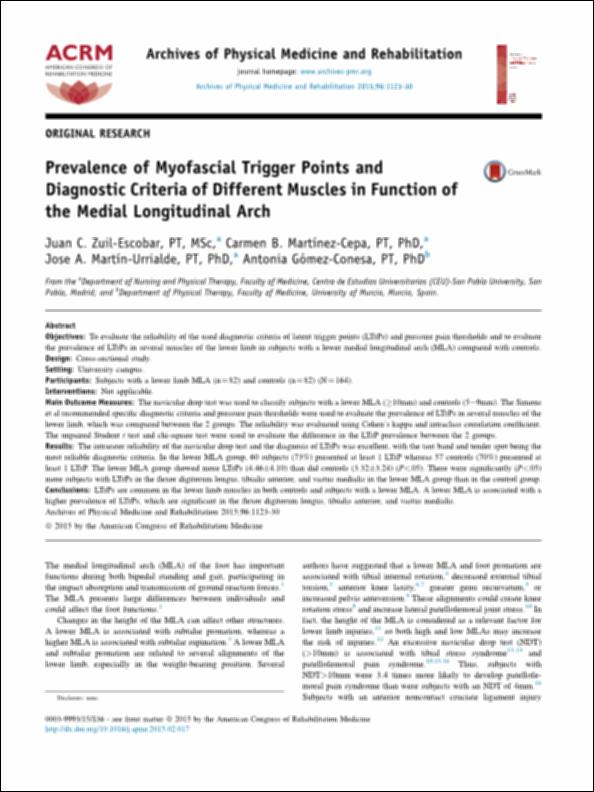Por favor, use este identificador para citar o enlazar este ítem:
http://hdl.handle.net/10637/13126Prevalence of Myofascial Trigger Points and Diagnostic Criteria of Different Muscles in Function of the Medial Longitudinal Arch.
| Título : | Prevalence of Myofascial Trigger Points and Diagnostic Criteria of Different Muscles in Function of the Medial Longitudinal Arch. |
| Autor : | Zuil Escobar, Juan Carlos Martín Urrialde, José Antonio Martínez Cepa, Carmen Gómez Conesa, Antonia |
| Materias: | Lower extremity; Prevalence; Rehabilitation |
| Resumen : | Abstract Objectives: To evaluate the reliability of the used diagnostic criteria of latent trigger points (LTrPs) and pressure pain thresholds and to evaluate the prevalence of LTrPs in several muscles of the lower limb in subjects with a lower medial longitudinal arch (MLA) compared with controls. Design: Cross-sectional study. Setting: University campus. Participants: Subjects with a lower limb MLA (nZ82) and controls (nZ82) (NZ164). Interventions: Not applicable. Main Outcome Measures: The navicular drop test was used to classify subjects with a lower MLA ( 10mm) and controls (5e9mm). The Simons et al recommended specific diagnostic criteria and pressure pain thresholds were used to evaluate the prevalence of LTrPs in several muscles of the lower limb, which was compared between the 2 groups. The reliability was evaluated using Cohen’s kappa and intraclass correlation coefficient. The unpaired Student t test and chi-square test were used to evaluate the difference in the LTrP prevalence between the 2 groups. Results: The intrarater reliability of the navicular drop test and the diagnosis of LTrPs was excellent, with the taut band and tender spot being the most reliable diagnostic criteria. In the lower MLA group, 60 subjects (73%) presented at least 1 LTrP whereas 57 controls (70%) presented at least 1 LTrP. The lower MLA group showed more LTrPs (4.464.10) than did controls (3.323.24) (P<.05). There were significantly (P<.05) more subjects with LTrPs in the flexor digitorum longus, tibialis anterior, and vastus medialis in the lower MLA group than in the control group. Conclusions: LTrPs are common in the lower limb muscles in both controls and subjects with a lower MLA. A lower MLA is associated with a higher prevalence of LTrPs, which are significant in the flexor digitorum longus, tibialis anterior, and vastus medialis. |
| Descripción : | En: Archives of Physical Medicine and Rehabilitation. e-ISSN 1532-821X vol. 96 (2015), pp 1123-1130 |
| URI : | http://hdl.handle.net/10637/13126 |
| Derechos: | http://creativecommons.org/licenses/by-nc-nd/4.0/deed.es |
| Fecha de publicación : | 5-nov-2015 |
| Centro : | Universidad San Pablo-CEU |
| Aparece en las colecciones: | Fisioterapia |
Los ítems de DSpace están protegidos por copyright, con todos los derechos reservados, a menos que se indique lo contrario.


